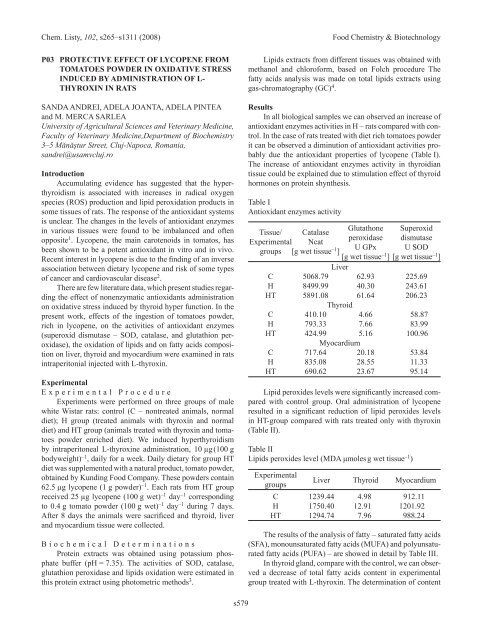3. FOOD ChEMISTRy & bIOTEChNOLOGy 3.1. Lectures
3. FOOD ChEMISTRy & bIOTEChNOLOGy 3.1. Lectures
3. FOOD ChEMISTRy & bIOTEChNOLOGy 3.1. Lectures
Create successful ePaper yourself
Turn your PDF publications into a flip-book with our unique Google optimized e-Paper software.
Chem. Listy, 102, s265–s1311 (2008) Food Chemistry & Biotechnology<br />
P03 PROTECTIVE EFFECT OF LyCOPENE FROM<br />
TOMATOES POwDER IN OxIDATIVE STRESS<br />
INDuCED by ADMINISTRATION OF L-<br />
ThyROxIN IN RATS<br />
SAnDA AnDREI, ADELA JOAnTA, ADELA PInTEA<br />
and M. MERCA SARLEA<br />
University of Agricultural Sciences and Veterinary Medicine,<br />
Faculty of Veterinary Medicine,Department of Biochemistry<br />
3–5 Mănăştur Street, Cluj-Napoca, Romania,<br />
sandrei@usamvcluj.ro<br />
Introduction<br />
Accumulating evidence has suggested that the hyperthyroidism<br />
is associated with increases in radical oxygen<br />
species (ROS) production and lipid peroxidation products in<br />
some tissues of rats. The response of the antioxidant systems<br />
is unclear. The changes in the levels of antioxidant enzymes<br />
in various tissues were found to be imbalanced and often<br />
opposite 1 . Lycopene, the main carotenoids in tomatos, has<br />
been shown to be a potent antioxidant in vitro and in vivo.<br />
Recent interest in lycopene is due to the finding of an inverse<br />
association between dietary lycopene and risk of some types<br />
of cancer and cardiovascular disease 2 .<br />
There are few literature data, which present studies regarding<br />
the effect of nonenzymatic antioxidants administration<br />
on oxidative stress induced by thyroid hyper function. In the<br />
present work, effects of the ingestion of tomatoes powder,<br />
rich in lycopene, on the activities of antioxidant enzymes<br />
(superoxid dismutase – SOD, catalase, and glutathion peroxidase),<br />
the oxidation of lipids and on fatty acids composition<br />
on liver, thyroid and myocardium were examined in rats<br />
intraperitonial injected with L-thyroxin.<br />
Experimental<br />
E x p e r i m e n t a l P r o c e d u r e<br />
Experiments were performed on three groups of male<br />
white Wistar rats: control (C – nontreated animals, normal<br />
diet); H group (treated animals with thyroxin and normal<br />
diet) and HT group (animals treated with thyroxin and tomatoes<br />
powder enriched diet). We induced hyperthyroidism<br />
by intraperitoneal L-thyroxine administration, 10 µg (100 g<br />
bodyweight) –1 , daily for a week. Daily dietary for group HT<br />
diet was supplemented with a natural product, tomato powder,<br />
obtained by Kunding Food Company. These powders contain<br />
62.5 µg lycopene (1 g powder) –1 . Each rats from HT group<br />
received 25 µg lycopene (100 g wet) –1 day –1 corresponding<br />
to 0.4 g tomato powder (100 g wet) –1 day –1 during 7 days.<br />
After 8 days the animals were sacrificed and thyroid, liver<br />
and myocardium tissue were collected.<br />
B i o c h e m i c a l D e t e r m i n a t i o n s<br />
Protein extracts was obtained using potassium phosphate<br />
buffer (pH = 7.35). The activities of SOD, catalase,<br />
glutathion peroxidase and lipids oxidation were estimated in<br />
this protein extract using photometric methods 3 .<br />
s579<br />
Lipids extracts from different tissues was obtained with<br />
methanol and chloroform, based on Folch procedure The<br />
fatty acids analysis was made on total lipids extracts using<br />
gas-chromatography (GC) 4 .<br />
Results<br />
In all biological samples we can observed an increase of<br />
antioxidant enzymes activities in H – rats compared with control.<br />
In the case of rats treated with diet rich tomatoes powder<br />
it can be observed a diminution of antioxidant activities probably<br />
due the antioxidant properties of lycopene (Table I).<br />
The increase of antioxidant enzymes activity in thyroidian<br />
tissue could be explained due to stimulation effect of thyroid<br />
hormones on protein shynthesis.<br />
Table I<br />
Antioxidant enzymes activity<br />
Glutathone Superoxid<br />
Tissue/ Catalase<br />
peroxidase dismutase<br />
Experimental ncat<br />
groups [g wet tissue –1 U GPx U SOD<br />
]<br />
[g wet tissue –1 ] [g wet tissue –1 ]<br />
Liver<br />
C 5068.79 62.93 225.69<br />
H 8499.99 40.30 24<strong>3.</strong>61<br />
HT 5891.08<br />
Thyroid<br />
61.64 206.23<br />
C 410.10 4.66 58.87<br />
H 79<strong>3.</strong>33 7.66 8<strong>3.</strong>99<br />
HT 424.99 5.16 100.96<br />
Myocardium<br />
C 717.64 20.18 5<strong>3.</strong>84<br />
H 835.08 28.55 11.33<br />
HT 690.62 2<strong>3.</strong>67 95.14<br />
Lipid peroxides levels were significantly increased compared<br />
with control group. Oral administration of lycopene<br />
resulted in a significant reduction of lipid peroxides levels<br />
in HT-group compared with rats treated only with thyroxin<br />
(Table II).<br />
Table II<br />
Lipids peroxides level (MDA μmoles g wet tissue –1 )<br />
Experimental<br />
groups<br />
Liver Thyroid Myocardium<br />
C 1239.44 4.98 912.11<br />
H 1750.40 12.91 1201.92<br />
HT 1294.74 7.96 988.24<br />
The results of the analysis of fatty – saturated fatty acids<br />
(SFA), monounsaturated fatty acids (MUFA) and polyunsaturated<br />
fatty acids (PUFA) – are showed in detail by Table III.<br />
In thyroid gland, compare with the control, we can observed<br />
a decrease of total fatty acids content in experimental<br />
group treated with L-thyroxin. The determination of content

















